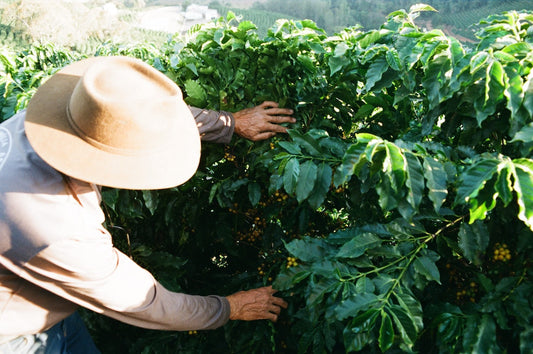
Brew Guide: Texturing Plant Based M*lk
Ahh Veganuary. Whilst most of us have entirely abandoned the – frankly flawed – concept of dry January, lots of us have kept our oar in with a more sustainable diet. If you read the title of this blog, then you’ll probably know we’re talking about plant-based milk alternatives which go hand in hand with veghanduary (soz, I think Brexit stole our sense of humour).
We just want to say that although we think Veganuary is great, we still think it’s really important to support the farmers that are paving the way for sustainable, regenerative agriculture. If you didn’t already know, Roastworks is based in Devon and we get stuck behind a lot of tractors here, and where there are tractors, there are usually farms. We like farms. We really believe that just because there is a vegan alternative for something it doesn’t always mean it’s better for the environment, or for you. It’s complicated and controversial, we know.
Anyway, before we get chastised for the previous comment, let’s tackle the issue on hand. Steaming (or texturing) milk is the all-consuming woe for any amateur barista. We’ve all had that awkward moment when the barista hands you a dodgy looking drink with an onion for latte art. You try your best to crack a smile, but inside you’re dying, and screaming “WTF is this??”. Well, that job gets even harder when you bring plant-based m*lks into the conversation.
Plant m*lks (we can’t say “milk” for legal reasons, none of which we wish to discuss right now) fortunately have improved masses in recent years. There was a time when all that seemed to be around was various brands of soy m*lk or almond m*lk. With the rise in popularity of plant-based diets, we’ve seen a boom in what plant m*lks are available on the shelves. Many brands have developed barista editions of their range designed specifically for texturing.
How well a milk steams and textures is based largely (but not solely) on the presence of protein. With regards to cow juice, some cafés run into issues at the start of autumn/winter (if they use a really good milk supplier) when the cows are transitioning from a largely grass diet to supplementing with silage. The protein structure within the milk is altered by the change in diet for a short period as the cows adjust. During this time the air bubbles that create microfoam can’t hold and they disperse, meaning it’s harder to achieve a smooth and consistent texture in the milk. You can wave goodbye to your cow’s milk cappuccino during that time. Anyway, that’s sort of off-topic but still interesting nonetheless.
So if you want to get better at texturing plant-based milk alternatives, see below. We’ve put together a few tips that we have found work for us. You will need a home espresso machine with a steam wand for this.
- Find the “barista edition” of your preferred plant m*lk as that will make things much easier.
- Always start with really cold m*lk. The warmer the m*lk is to begin with the harder it will be to work with.
- You’re going to need some ears and some eyes. Hands help too. We’re going to use our sight, sound and touch to determine the texture and temperature of the m*lk. Thermometers are mostly useless for this application.
- Always steam in a bigger jug than the quantity of m*lk you need, especially when you are starting out. As you introduce air into the m*lk the volume will expand so you want a bit of headroom in the jug. We recommend not filling the jug more than ⅓ to start with.
- Start by positioning the steam wand tip just below the surface of the m*lk, at an angle. Try to keep the jug flat and position the steam wand so that it’s somewhere between the middle and the side of the jug.
- Turn the steam wand on. You’re looking to force air into the m*lk with the steam pressure. This is called “stretching”. You’re looking for a sort of ripping or tearing sound. Getting this bit right is everything with plant-based m*ilks, so you’ll need a lot of practice. Control the rate of stretch by moving the steam wand tip lower or higher in the m*lk until you’re just hearing the tearing sound. Not too much or you’ll end up with really foamy, horrible m*lk. All in all, you only want to stretch the m*lk for a couple of seconds. Maybe 4 or 5 in total.
- The second stage is heating. Once you’ve got the right amount of air in to the m*ilk, it’s time to get your swirl on. Angle the jug back towards you and up a bit to submerge the steam wand further, you should start seeing the m*lk spin. The tearing sound should stop. This will break the air bubbles down and heat up the m*lk. Keep your palm flat on the side of the jug and when it gets too hot to touch you know you’ve hit the right temperature.
- Your m*ilk should look like, and have the consistency of white emulsion paint, Dulux, to be precise (joking, of course). There shouldn’t be loads of big bubbles and it shouldn’t be separating immediately. If the texture is too thick and gloopy you’ve stretched the milk too far. If it’s thin and “milky” (and the steam wand starts to scream like the devil rising from the depths of hell), then you haven’t introduced enough air in. If there are loads of bigger bubbles and the m*lk is all frothy, try refining the stretching and make sure there isn’t any tearing sounds later on in the process.
- Try different plant m*lks. We think oat m*lk is the best we’ve found so far, and some brands are better than others. Do a little experiment and see what you find easiest to work with. We can definitely vouch for Minor Figures, Oatly and Rude Health.
- Some soy m*lks have a tendency to curdle. You can largely overcome this by being gentle on the heat and using lower acidity coffees. Don’t overheat soy milk and try using a darker roast coffee.
- ALL plant-based m*lk alternatives are harder to work with than cow juice, so don’t be frustrated if it’s not going your way. It takes lots of practice to get good at.
- Remember, you can only pour good latte art if you have correctly textured m*lk. Don’t get carried away with trying to stack your tulip if your texture is rubbish. Instead, spend the time getting the m*lk right.




